Influence of Luminescent Properties of Powders on the Fabrication of Scintillation Ceramics by Stereolithography 3D Printing
Abstract
1. Introduction
2. Materials and Methods
2.1. Starting Materials
2.2. Slurry Preparation and 3D Printing
2.3. Characterization Techniques
3. Results and Discussion
4. Conclusions
Supplementary Materials
Author Contributions
Funding
Institutional Review Board Statement
Informed Consent Statement
Data Availability Statement
Acknowledgments
Conflicts of Interest
References
- Schlotter, P.; Schmidt, R.; Schneider, J. Luminescence conversion of blue light emitting diodes. Appl. Phys. A.-Mater. 1997, 64, 417–418. [Google Scholar] [CrossRef]
- Smet, P.F.; Parmentier, A.B.; Poelman, D. Selecting conversion phosphors for white light-emitting diodes. J. Electrochem. Soc. 2011, 158, R37. [Google Scholar] [CrossRef]
- Kaminskii, A.A. Laser crystals and ceramics: Recent advances. Laser Photonics Rev. 2007, 1, 93–177. [Google Scholar] [CrossRef]
- Lupei, V.; Lupei, A.; Pavel, N.; Taira, T.; Ikesue, A. Comparative investigation of spectroscopic and laser emission characteristics under direct 885-nm pump of concentrated Nd: YAG ceramics and crystals. Appl. Phys. B.-Laser O. 2001, 73, 757–762. [Google Scholar] [CrossRef]
- Kaminskii, A.A.; Balashov, V.V.; Cheshev, E.A.; Kopylov, Y.L.; Koromyslov, A.L.; Krokhin, O.N.; Kravchenko, V.B.; Lopukhin, K.V.; Shemet, V.V. High quality Y3Al5O12 doped transparent ceramics for laser applications, role of sintering additives. Opt. Mat. 2017, 71, 103–108. [Google Scholar] [CrossRef]
- Iyudin, A.F.; Svertilov, S.I. Application of scintillation detectors in cosmic experiments. In Engineering of Scintillation Materials and Radiation Technologies. ISMART 2018; Korzhik, M., Gektin, A., Eds.; Springer Proceedings in Physics; Springer: Berlin/Heidelberg, Germany, 2019; Volume 227, pp. 165–185. [Google Scholar] [CrossRef]
- Lecoq, P.; Gektin, A.; Korzhik, M. Inorganic Scintillators for Detector Systems. Particle Acceleration and Detection; Springer: Berlin/Heidelberg, Germany, 2017; p. 408. [Google Scholar] [CrossRef]
- Yamamoto, S.; Nitta, H. Development of an event-by-event based radiation imaging detector using GGAG: A ceramic scintillator for X-ray CT. Nucl. Instrum. Meth. A 2018, 900, 25–31. [Google Scholar] [CrossRef]
- Ji, T.; Wang, T.; Li, H.; Peng, Q.; Tang, H.; Hu, S.; Yakovlev, A.; Zhong, Y.; Xu, X. Ce3+ doped yttrium aluminum garnet transparent ceramics for high-resolution X-ray imaging. Adv. Opt. Mater. 2022, 10, 2102056. [Google Scholar] [CrossRef]
- An, L.; Auffay, E.; Bettim, F.; Dall’Omo, F.; Gascon, D.; Golutvin, A.; Guz, Y.; Kholodenko, S.; Martinazzoli, L.; Mazorra De Cos, J.; et al. Performance of a spaghetti calorimeter prototype with tungsten absorber and garnet crystal fibres. Nucl. Instrum. Meth. A 2023, 1045, 167629. [Google Scholar] [CrossRef]
- Alenkov, V.; Buzanov, O.; Dosovitskiy, G.; Egorychev, V.; Fedorov, A.; Golutvin, A.; Guz, Y.; Jacobsson, R.; Korjik, M.; Kozlov, D.; et al. Irradiation studies of a multi-doped Gd3Al2Ga3O12 scintillator. Nucl. Instrum. Meth. A 2019, 916, 226–229. [Google Scholar] [CrossRef]
- Kamada, K.; Shoji, Y.; Kochurikhin, V.V.; Nagura, A.; Okumura, S.; Yamamoto, S.; Yeom, J.Y.; Kurosawa, S.; Pejchal, J.; Yokota, Y.; et al. Large size Czochralski growth and scintillation properties of Mg2+ co-doped Ce:Gd3Ga3Al2O12. IEEE Trans. Nucl. Sci. 2016, 63, 443–447. [Google Scholar] [CrossRef]
- Korzhik, M.; Alenkov, V.; Buzanov, O.; Fedorov, A.; Dosovitskiy, G.; Grigorjeva, L.; Mechinsky, V.; Sokolov, P.; Tratsiak, Y.; Zolotarjovs, A.; et al. Nanoengineered Gd3Al2Ga3O12 scintillation materials with disordered garnet structure for novel detectors of ionizing radiation. Cryst. Res. Technol. 2019, 54, 1800172. [Google Scholar] [CrossRef]
- Tamulaitis, G.; Vasilyev, A.; Korzhik, M.; Mazzi, A.; Gola, A.; Nargelas, S.; Vaitkevicius, A.; Fedorov, A.; Kozlov, D. Improvement of the time resolution of radiation detectors based on Gd3Al2Ga3O12 scintillators with SiPM readout. IEEE Trans. Nucl. Sci. 2019, 66, 1879–1888. [Google Scholar] [CrossRef]
- Zhu, Y.; Qian, S.; Wang, Z.; Guo, H.; Ma, L.; Wang, Z.; Wu, Q. Scintillation properties of GAGG: Ce ceramic and single crystal. Opt. Mat. 2020, 105, 109964. [Google Scholar] [CrossRef]
- Korjik, M.; Bondarau, A.; Dosovitskiy, G.; Dubov, V.; Gordienko, K.; Karpuk, P.; Komendo, I.; Kuznetsova, D.; Mechinsky, V.; Pustovarov, V.; et al. Lanthanoid-doped quaternary garnets as phosphors for high brightness cathodoluminescence-based light sources. Heliyon 2022, 8, E10193. [Google Scholar] [CrossRef] [PubMed]
- Korzhik, M.; Borisevich, A.; Fedorov, A.; Gordienko, E.; Karpyuk, P.; Dubov, V.; Sokolov, P.; Mikhlin, A.; Dosovitskiy, G.; Mechinsky, V.; et al. The scintillation mechanisms in Ce and Tb doped (GdxY1-x)Al2Ga3O12 quaternary garnet structure crystalline ceramics. J. Lumin. 2021, 234, 117933. [Google Scholar] [CrossRef]
- Korzhik, M.; Abashev, R.; Fedorov, A.; Dosovitskiy, G.; Gordienko, E.; Kamenskikh, I.; Kazlou, D.; Kuznecova, D.; Mechinsky, V.; Pustovarov, V.; et al. Towards effective indirect radioisotope energy converters with bright and radiation hard scintillators of (Gd,Y)3Al2Ga3O12 family. Nucl. Eng. Technol. 2022, 54, 2579–2585. [Google Scholar] [CrossRef]
- Dujardin, C.; Auffray, E.; Bourret, E.; Dorenbos, P.; Lecoq, P.; Nikl, M.; Vasil’ev, A.N.; Yoshikawa, A.; Zhu, R. Needs, trends, and advances in inorganic scintillators. IEEE Trans. Nucl. Sci. 2018, 65, 1977–1997. [Google Scholar] [CrossRef]
- Tian, F.; Ikesue, A.; Li, J. Progress and perspectives on composite laser ceramics: A review. J. Eur. Ceram. Soc. 2022, 42, 1833–1851. [Google Scholar] [CrossRef]
- Ievlev, V.M.; Putlyaev, V.I.; Safronova, T.V.; Evdokimov, P.V. Additive technologies for making highly permeable inorganic materials with tailored morphological architectonics for medicine. Inorg. Mater. 2015, 51, 1297–1315. [Google Scholar] [CrossRef]
- Zocca, A.; Colombo, P.; Gomes, C.M.; Günster, J. Additive manufacturing of ceramics: Issues, potentialities, and opportunities. J. Am. Ceram. Soc. 2015, 98, 1983–2001. [Google Scholar] [CrossRef]
- Travitzky, N.; Bonet, A.; Dermeik, B.; Fey, T.; Filbert-Demut, I.; Schlier, L.; Schlordt, T.; Greil, P. Additive manufacturing of ceramic-based materials. Adv. Eng. Mater. 2014, 16, 729–754. [Google Scholar] [CrossRef]
- Fedorov, A.A.; Dubov, V.V.; Ermakova, L.V.; Bondarev, A.G.; Karpyuk, P.V.; Korzhik, M.V.; Kuznetsova, D.E.; Mechinsky, V.A.; Smyslova, V.G.; Dosovitskiy, G.A.; et al. Gd3Al2Ga3O12:Ce: Scintillation ceramic elements for measuring ionizing radiation in gases and liquids. Instrum. Exp. Tech. 2023, 2. accepted. [Google Scholar]
- Konstantinou, G.; Lecoq, P.; Benlloch, J.M.; Gonzalez, A.J. Metascintillators for ultrafast gamma detectors: A review of current state and future perspectives. IEEE Trans. Radiat. Plasma Med. Sci. 2021, 6, 5–15. [Google Scholar] [CrossRef]
- Pagano, F.; Kratochwil, N.; Salomoni, M.; Pizzichemi, M.; Paganoni, M.; Auffray, E. Advances in heterostructured scintillators: Toward a new generation of detectors for TOF-PET. Phys. Med. Biol. 2022, 67, 135010. [Google Scholar] [CrossRef] [PubMed]
- Lecoq, P.; Konstantinou, G.; Latella, R.; Moliner, L.; Nuyts, J.; Zhang, L.; Gonzalez, A.J. Metascintillators: New results for TOF-PET applications. IEEE Trans. Radiat. Plasma Med. Sci. 2022, 6, 510–516. [Google Scholar] [CrossRef]
- Yang, Y.; Liu, T.; Bi, L.; Deng, L. Recent advances in development of magnetic garnet thin films for applications in spintronics and photonics. J. Alloys Compd. 2021, 860, 158235. [Google Scholar] [CrossRef]
- Telegin, A.; Sukhorukov, Y. Magnetic Semiconductors as Materials for Spintronics. Magnetochemistry 2022, 8, 173. [Google Scholar] [CrossRef]
- Nemeth, Z.; Nomura, K.; Ito, Y. Room temperature ferromagnetism in dilute iron-doped yttrium aluminum garnet polycrystals. J. Phys. Chem. C 2009, 113, 20044–20049. [Google Scholar] [CrossRef]
- Neupane, D.; Hulsebosch, L.; Ali, K.S.S.; Bhattarai, R.; Shen, X.; Pathak, A.K.; Mishra, S.R. Enhanced magnetocaloric effect in aluminum doped Gd3Fe5-xAlxO12 garnet: Structural, magnetic, and Mössbauer study. Materialia 2022, 21, 101301. [Google Scholar] [CrossRef]
- Zhang, G.; Carloni, D.; Wu, Y. 3D printing of transparent YAG ceramics using copolymer-assisted slurry. Ceram. Int. 2020, 46, 17130–17134. [Google Scholar] [CrossRef]
- Seeley, Z.; Yee, T.; Cherepy, N.; Drobshoff, A.; Herrera, O.; Ryerson, R.; Payne, S.A. 3D printed transparent ceramic YAG laser rods: Matching the core-clad refractive index. Opt. Mat. 2020, 107, 110121. [Google Scholar] [CrossRef]
- Halloran, J.W. Ceramic stereolithography: Additive manufacturing for ceramics by photopolymerization. Annu. Rev. Mater. Res. 2016, 46, 19–40. [Google Scholar] [CrossRef]
- Komissarenko, D.A.; Sokolov, P.S.; Evstigneeva, A.D.; Shmeleva, I.A.; Dosovitsky, A.E. Rheological and curing behavior of acrylate-based suspensions for the DLP 3D printing of complex zirconia parts. Materials 2018, 11, 2350. [Google Scholar] [CrossRef] [PubMed]
- Komissarenko, D.A.; Sokolov, P.S.; Evstigneeva, A.D.; Slyusar, I.V.; Nartov, A.S.; Volkov, P.A.; Lyskov, N.V.; Evdokimov, P.V.; Putlayev, V.I.; Dosovitsky, A.E. DLP 3D printing of scandia-stabilized zirconia ceramics. J. Eur. Ceram. Soc. 2021, 41, 684–690. [Google Scholar] [CrossRef]
- Sokolov, P.S.; Komissarenko, D.A.; Belus, S.K.; Dosovitskiy, G.A.; Kozlov, D.Y.; Dosovitskiy, A.E.; Korzhik, M.V. 3D printing of composite reflectors for enhanced light collection in scintillation detectors. Opt. Mat. 2020, 108, 110393. [Google Scholar] [CrossRef]
- Li, Y.; Wang, M.; Wu, H.; He, F.; Chen, Y.; Wu, S. Cure behavior of colorful ZrO2 suspensions during digital light processing (DLP) based stereolithography process. J. Eur. Ceram. Soc. 2019, 39, 4921–4927. [Google Scholar] [CrossRef]
- Goldberg, M.; Obolkina, T.; Smirnov, S.; Protsenko, P.; Titov, D.; Antonova, O.; Konovalov, A.; Kudryavtsev, E.; Sviridova, I.; Kirsanova, V.; et al. The influence of Co additive on the sintering, mechanical properties, cytocompatibility, and digital light processing based stereolithography of 3Y-TZP-5Al2O3 ceramics. Materials 2020, 13, 2789. [Google Scholar] [CrossRef]
- Fournier, S.; Chevalier, J.; Baeza, G.P.; Chaput, C.; Louradour, E.; Sainot, P.; Cavoret, J.; Reveron, H. Ceria-stabilized zirconia-based composites printed by stereolithography: Impact of the processing method on the ductile behaviour and its transformation features. J. Eur. Ceram. Soc. 2022; in press. [Google Scholar] [CrossRef]
- Inserra, B.; Coppola, B.; Montanaro, L.; Tulliani, J.-M.; Palmero, P. Preparation and characterization of Ce-ZrO2/Al2O3 composites by DLP-based stereolithography. J. Eur. Ceram. Soc. 2022; in press. [Google Scholar] [CrossRef]
- Cailliet, S.; Roumanie, M.; Crourxe-Barghorn, C.; Bernard-Grager, G.; Laucournet, R. Y-TZP, Ce-TZP and as-synthesized Ce-TZP/Al2O3 materials in the development of high loading rate digital light processing formulations. Ceram. Int. 2021, 47, 3892–3900. [Google Scholar] [CrossRef]
- Chang, J.; Zou, D.; Wang, X.; Yu, Y.; Chen, Q.; Zhang, G. The 3D printing and sintering preparation and coloring mechanism analysis of colorful ZrO2 ceramics parts. Mater. Today Commun. 2022; in press. [Google Scholar] [CrossRef]
- Hostaša, J.; Schwentenwein, M.; Toci, G.; Esposito, L.; Brouczek, D.; Piancastelli, A.; Pirri, A.; Patrizi, B.; Vannini, M.; Biasini, V. Transparent laser ceramics by stereolithography. Scripta Mater. 2020, 187, 194–196. [Google Scholar] [CrossRef]
- Wang, T.; Zhang, J.; Zhang, N.; Wang, S.; Wu, B.; Jia, Z.; Tao, X. The characteristics of high-quality Yb: YAG single crystal fibers grown by a LHPG method and the effects of their discoloration. RSC Adv. 2019, 9, 22567–22575. [Google Scholar] [CrossRef] [PubMed]
- Cooperstein, I.; Indukuri, S.R.K.C.; Bouketov, A.; Levy, U.; Magdassi, S. 3D printing of micrometer-sized transparent ceramics with on-demand optical-gain properties. Adv. Mat. 2020, 32, 2001675. [Google Scholar] [CrossRef]
- Kumar, G.A.; Lu, J.; Kaminskii, A.A.; Ueda, K.I.; Yagi, H.; Yanagitani, T. Spectroscopic and stimulated emission Characteristics of Nd3+ in transparent YAG ceramics. IEEE J. Quantum Electron. 2004, 40, 747–758. [Google Scholar] [CrossRef]
- Dosovitskiy, G.A.; Karpyuk, P.V.; Evdokimov, P.V.; Kuznetsova, D.E.; Mechinsky, V.A.; Borisevich, A.E.; Fedorov, A.A.; Putlayev, V.I.; Dosovitskiy, A.E.; Korjik, M.V. First 3D-printed complex inorganic polycrystalline scintillator. CrystEngComm 2017, 19, 4260–4264. [Google Scholar] [CrossRef]
- Hu, S.; Liu, Y.; Zhang, Y.; Xue, Z.; Wang, Z.; Zhou, G.; Lu, C.; Li, H.; Wang, S. 3D printed ceramic phosphor and the photoluminescence property under blue laser excitation. J. Eur. Ceram. Soc. 2019, 39, 2731–2738. [Google Scholar] [CrossRef]
- Ueda, J.; Tanabe, S. Review of luminescent properties of Ce3+-doped garnet phosphors: New insight into the effect of crystal and electronic structure. Opt. Mat. X 2019, 1, 100018. [Google Scholar] [CrossRef]
- Li, J.G.; Ikegami, T.; Lee, J.H.; Mori, T. Low-temperature fabrication of transparent yttrium aluminum garnet (YAG) ceramics without additives. J. Am. Ceram. Soc. 2000, 83, 961–963. [Google Scholar] [CrossRef]
- Zhou, D.; Qi, H.; Zhou, B.; Wang, Y.; Zhou, Z.; Wang, L.; Xu, J.; Shi, Y. Mixed precipitants derived nanocrystalline powders and RE doped LuAG transparent ceramics. Ceram. Int. 2022, 48, 24788–24792. [Google Scholar] [CrossRef]
- Xu, X.; Sun, X.; Liu, H.; Li, J.G.; Li, X.; Huo, D.; Liu, S. Synthesis of monodispersed spherical yttrium aluminum garnet (YAG) powders by a homogeneous precipitation method. J. Am. Ceram. Soc. 2012, 95, 3821–3826. [Google Scholar] [CrossRef]
- Karpyuk, P.V.; Dosovitskiy, G.A.; Kuznetsova, D.E.; Gordienko, E.V.; Fedorov, A.A.; Mechinsky, V.A.; Dosovitskiy, A.E.; Korzhik, M.V. Ceramic scintillation materials—Approaches, challenges and possibilities. In Engineering of Scintillation Materials and Radiation Technologies. ISMART 2018; Korzhik, M., Gektin, A., Eds.; Springer Proceedings in Physics; Springer: Cham, Switzerland, 2019; Volume 227, pp. 57–74. [Google Scholar] [CrossRef]
- Klee, J.E.; Maier, M.; Fic, C.P. Applied Photochemistry in Dental Materials: From Beginnings to State of the Art. In Dyes and Chromophores in Polymer Science; Lalevée, J., Fouassier, J.-P., Eds.; Wiley: Hoboken, NJ, USA, 2015. [Google Scholar] [CrossRef]
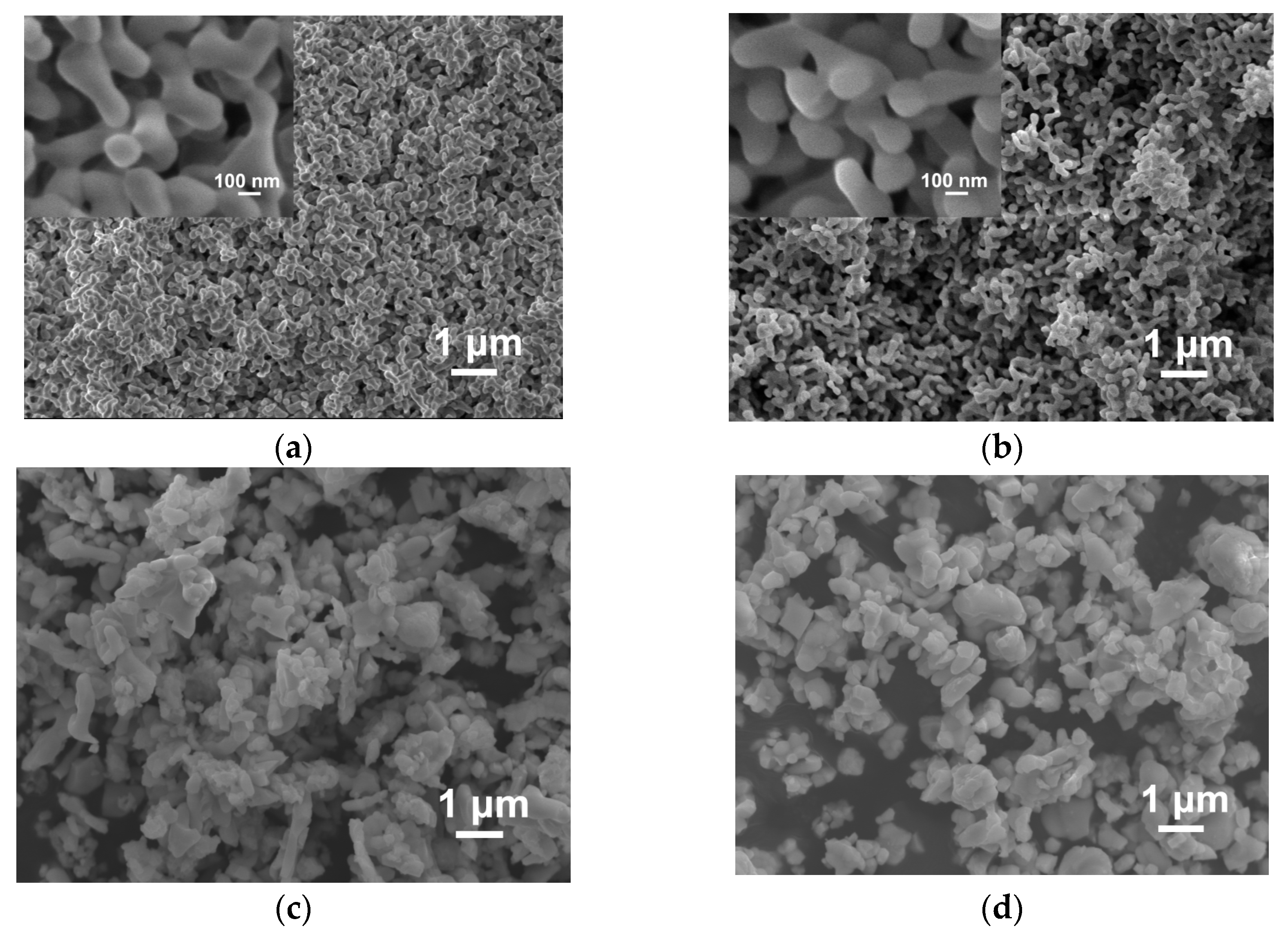
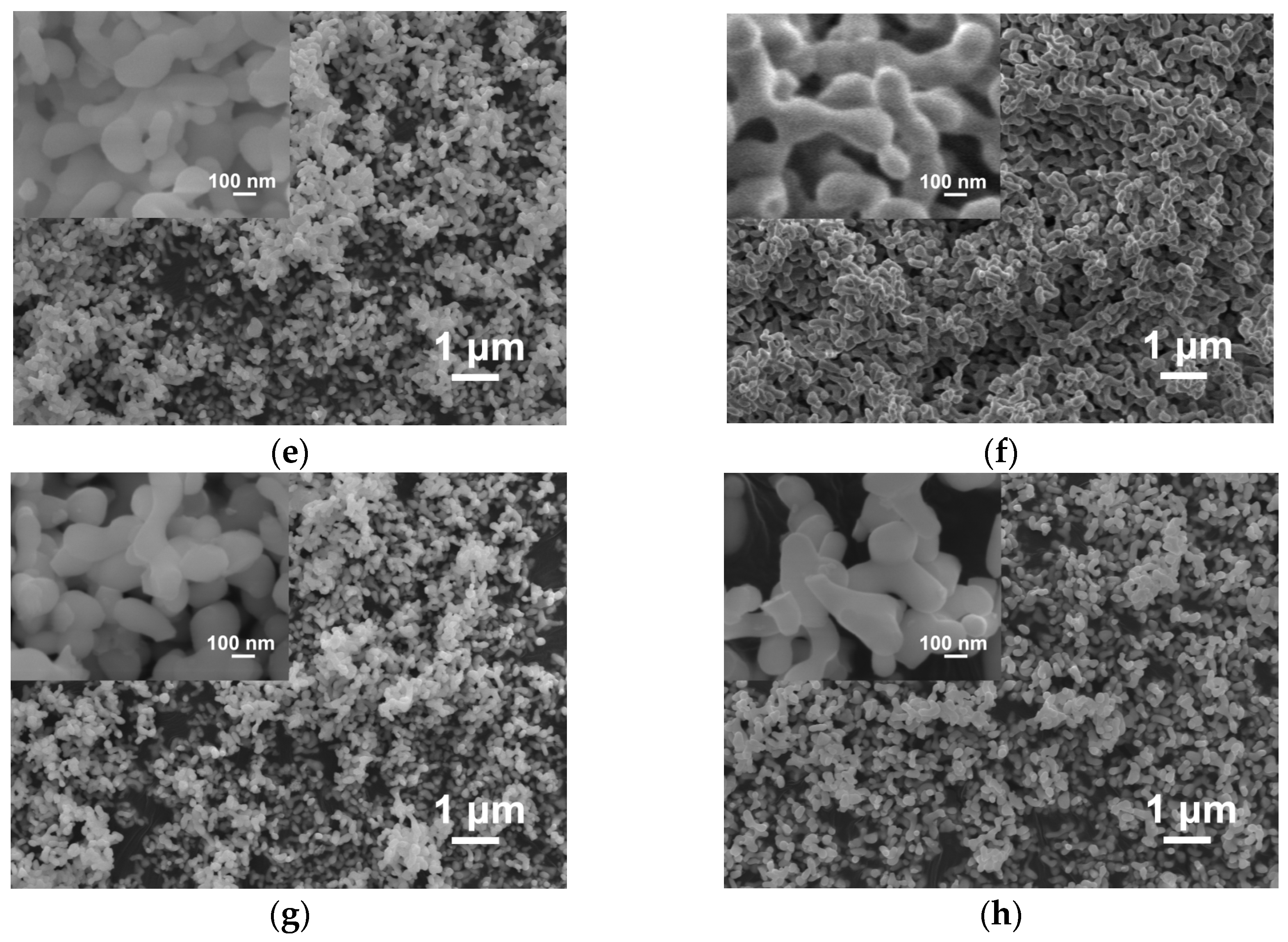
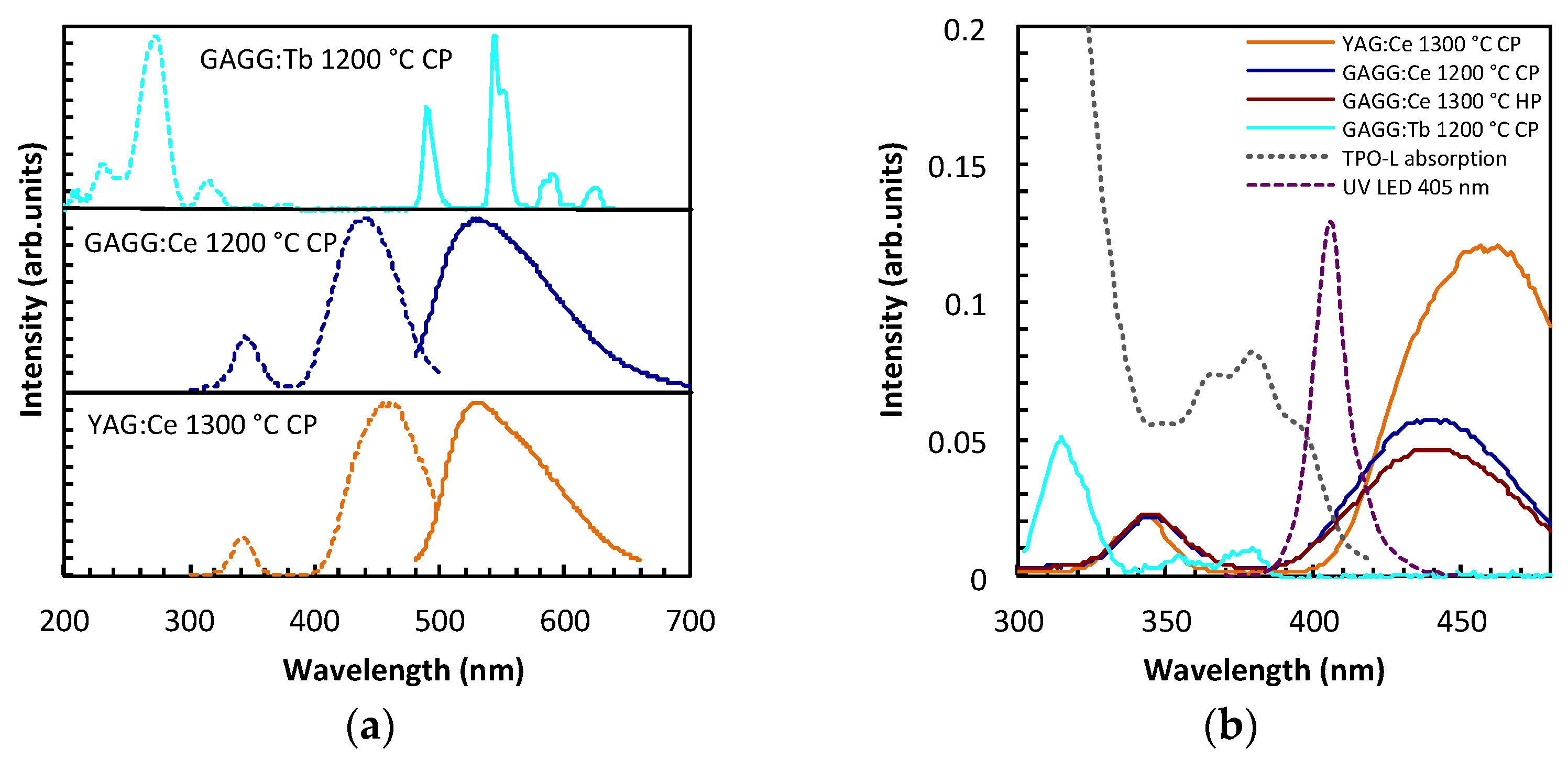
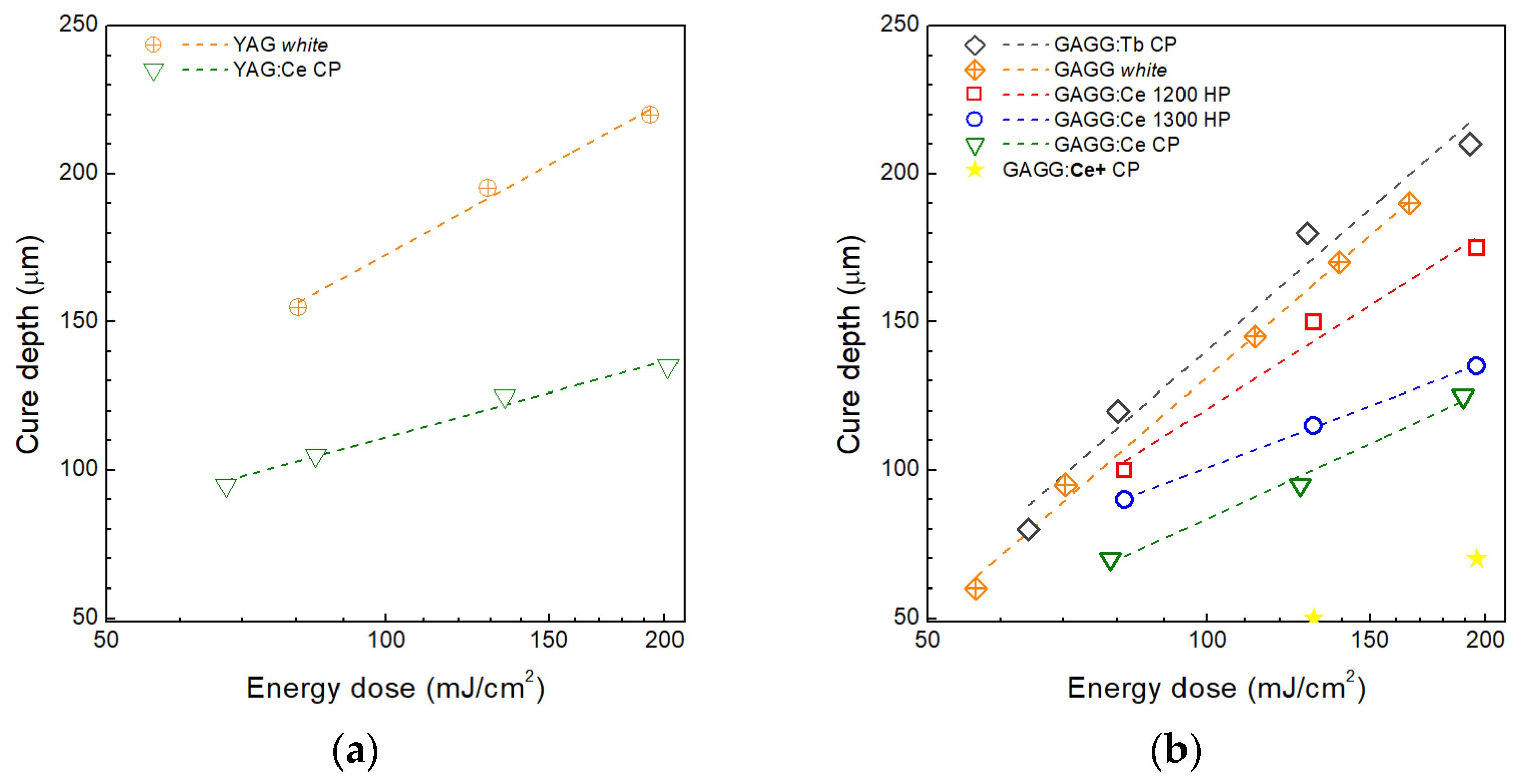

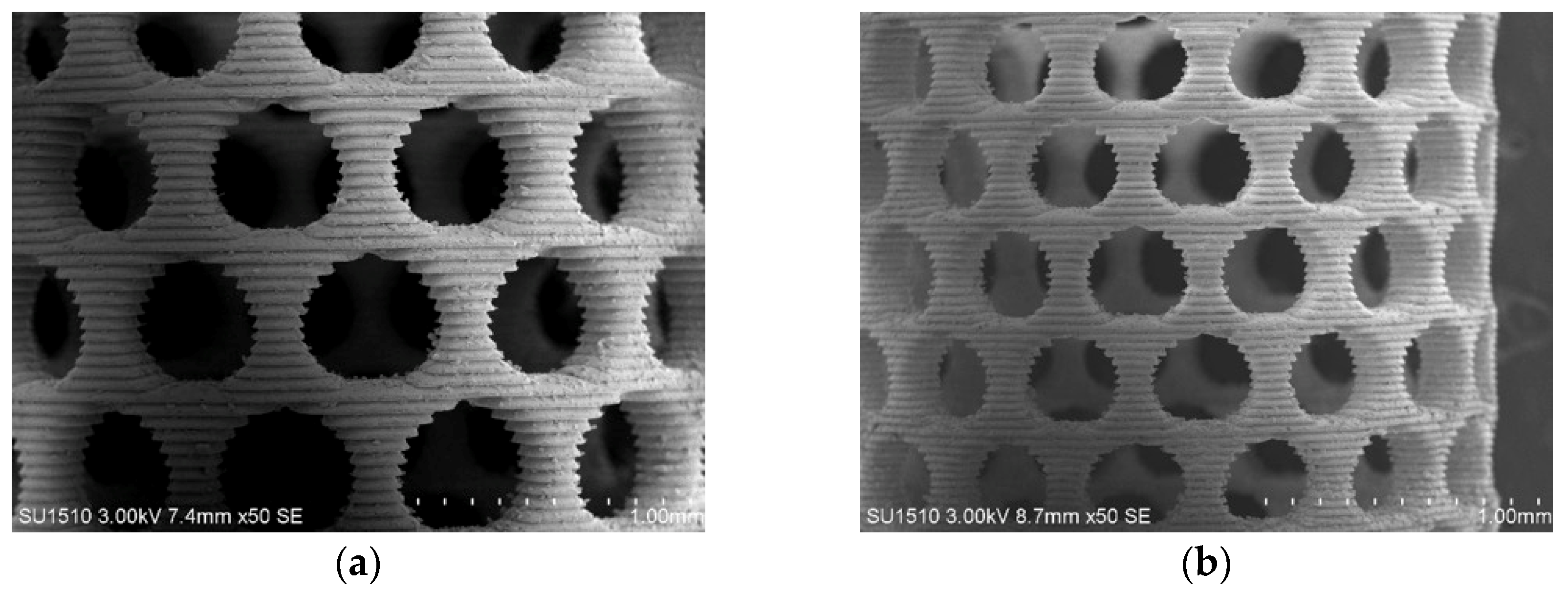
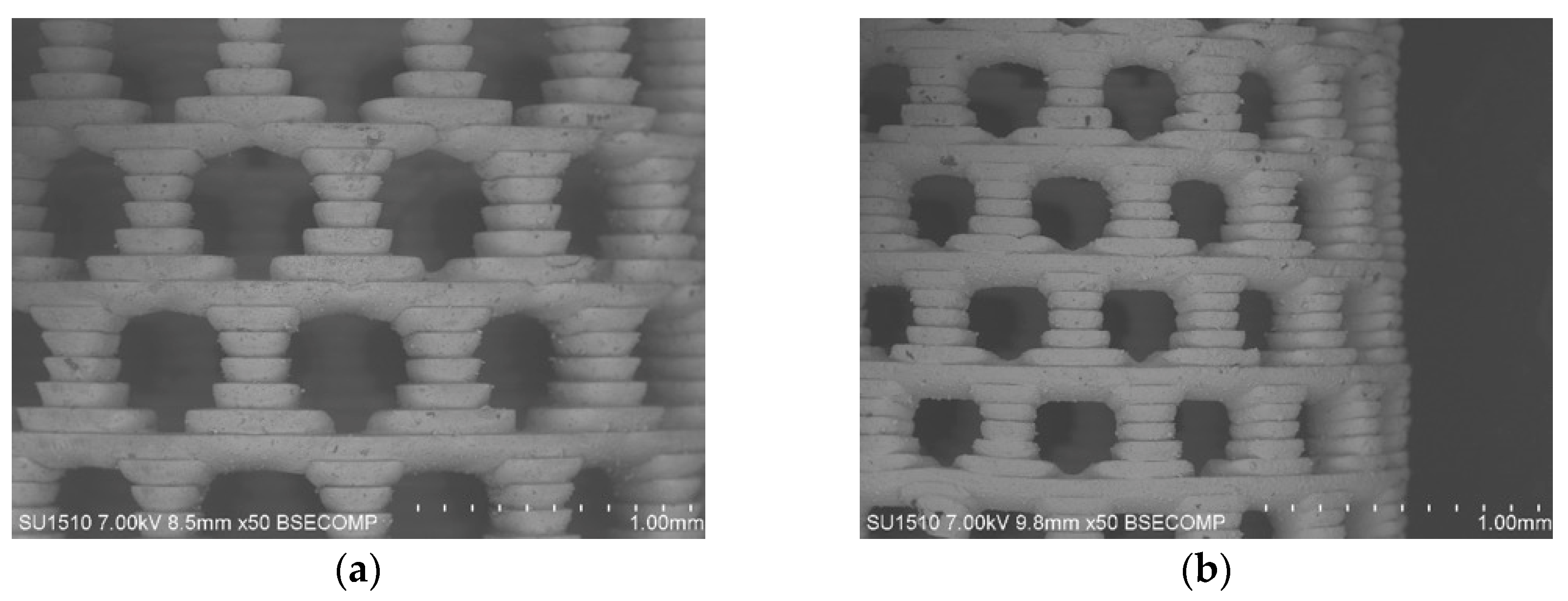
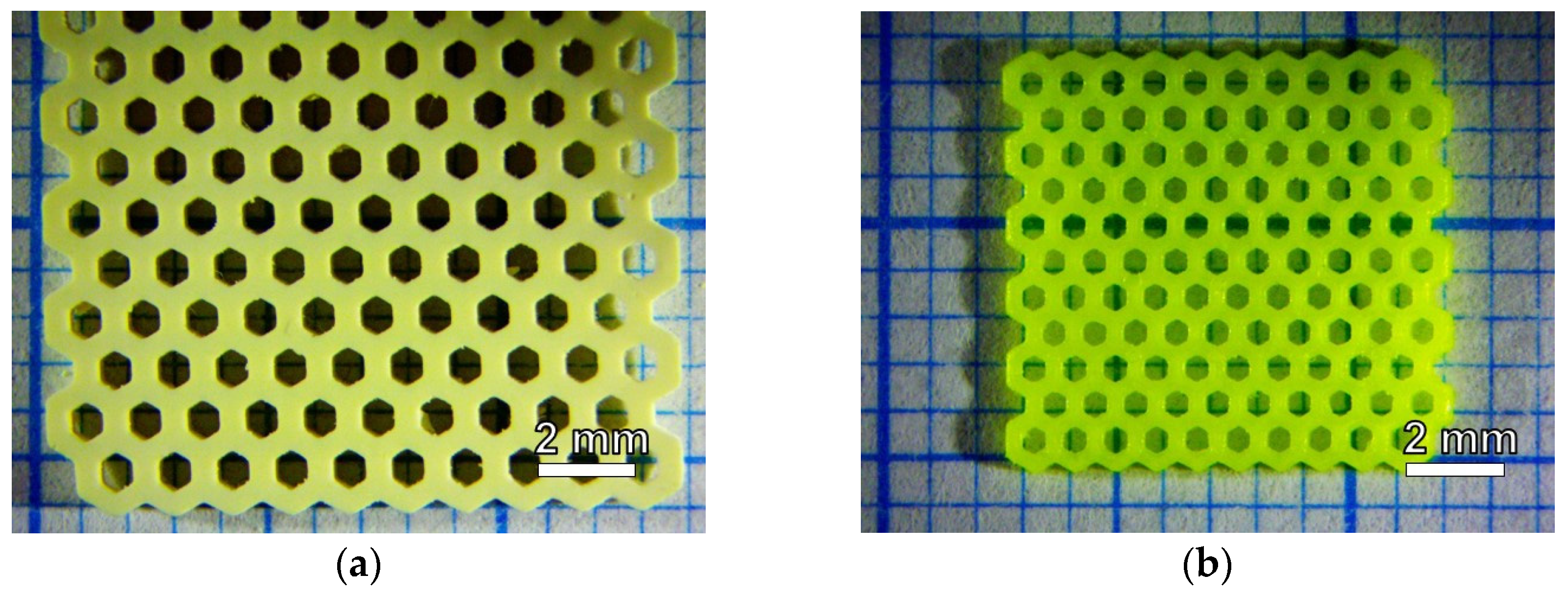

| Abbreviation | Synthesis Approach | Composition | Calcining Temperature (°C) |
|---|---|---|---|
| YAG white | Coprecipitation | Y3Al5O12 | 1300 |
| YAG:Ce CP | Coprecipitation | Y2.97Ce0.03Al5O12 | 1300 |
| GAGG:Ce 1200 HP | Homogeneous precipitation | Gd2.988Ce0.012Al2Ga3O12 | 1200 |
| GAGG:Ce 1300 HP | Homogeneous precipitation | Gd2.988Ce0.012Al2Ga3O12 | 1300 |
| GAGG:Ce CP | Coprecipitation | Gd2.988Ce0.012Al2Ga3O12 | 1200 |
| GAGG:Ce+ CP | Coprecipitation | Gd2.97Ce0.03Al2Ga3O12 | 1200 |
| GAGG:Tb CP | Coprecipitation | Gd2.88Tb0.12Al2Ga3O12 | 1200 |
| GAGG white | Coprecipitation | Gd3Al2Ga3O12 | 1200 |
| Powder | BET Specific Surface, m2/g | d10, μm | d50, μm | d90, μm |
|---|---|---|---|---|
| YAG white | 9.7 | 0.11 | 0.19 | 0.88 |
| YAG:Ce CP | 10 | 0.11 | 0.18 | 0.64 |
| GAGG:Ce 1200 HP | 5.2 | 0.46 | 1.00 | 2.10 |
| GAGG:Ce 1300 HP | 3.6 | 0.65 | 1.22 | 2.27 |
| GAGG:Ce CP | 7.3 | 0.10 | 0.18 | 1.00 |
| GAGG:Ce+ CP | 4.3 | 0.10 | 0.16 | 0.36 |
| GAGG:Tb CP | 8.2 | 0.11 | 0.35 | 1.21 |
| GAGG white | — | 0.10 | 0.34 | 1.06 |
| Powder | Dp (μm) | Ec (mJ/cm2) | R2 |
|---|---|---|---|
| YAG white | 81 (16) | 17 (7) | 0.96 |
| YAG:Ce CP | 37 (3) | 5 (1) | 0.99 |
| GAGG:Ce 1200 HP | 86 (13) | 24 (6) | 0.98 |
| GAGG:Ce 1300 HP | 51 (1) | 14 (1) | 0.99 |
| GAGG:Ce CP | 63 (6) | 26 (4) | 0.99 |
| GAGG:Tb CP | 118 (13) | 30 (5) | 0.97 |
| GAGG white | 118 (4) | 33 (1) | 0.99 |
| Layer Thickness | Powder | |||
| YAG:Ce CP | YAG white | GAGG:Ce 1200 HP | GAGG:Ce 1300 HP | |
| 25 μm | — | — | — | Dose:50 |
| 50 μm | Dose: 50 | — | Dose: 80 | Dose:75 |
| 75 μm | Dose: 120 | — | Dose: 130 | Dose: 110 |
| 100 μm | Printing unavailable | Dose: 90 | Dose: 145 | Dose: 160 |
| Layer Thickness | Powder | |||
| GAGG:Ce CP | GAGG:Ce+ CP | GAGG:Tb CP | GAGG white | |
| 25 μm | Dose: 80 | Dose: 130 | Dose: 56 | — |
| 50 μm | Dose: 100 | Printing unavailable | Dose: 70 | — |
| 75 μm | Dose: 140 | Printing unavailable | Dose: 80 | — |
| 100 μm | Dose: 190 | Printing unavailable | Dose: 110 | Dose: 110 |
Disclaimer/Publisher’s Note: The statements, opinions and data contained in all publications are solely those of the individual author(s) and contributor(s) and not of MDPI and/or the editor(s). MDPI and/or the editor(s) disclaim responsibility for any injury to people or property resulting from any ideas, methods, instructions or products referred to in the content. |
© 2023 by the authors. Licensee MDPI, Basel, Switzerland. This article is an open access article distributed under the terms and conditions of the Creative Commons Attribution (CC BY) license (https://creativecommons.org/licenses/by/4.0/).
Share and Cite
Ermakova, L.V.; Dubov, V.V.; Saifutyarov, R.R.; Kuznetsova, D.E.; Malozovskaya, M.S.; Karpyuk, P.V.; Dosovitskiy, G.A.; Sokolov, P.S. Influence of Luminescent Properties of Powders on the Fabrication of Scintillation Ceramics by Stereolithography 3D Printing. Ceramics 2023, 6, 43-57. https://doi.org/10.3390/ceramics6010004
Ermakova LV, Dubov VV, Saifutyarov RR, Kuznetsova DE, Malozovskaya MS, Karpyuk PV, Dosovitskiy GA, Sokolov PS. Influence of Luminescent Properties of Powders on the Fabrication of Scintillation Ceramics by Stereolithography 3D Printing. Ceramics. 2023; 6(1):43-57. https://doi.org/10.3390/ceramics6010004
Chicago/Turabian StyleErmakova, Lydia V., Valery V. Dubov, Rasim R. Saifutyarov, Daria E. Kuznetsova, Maria S. Malozovskaya, Petr V. Karpyuk, Georgy A. Dosovitskiy, and Petr S. Sokolov. 2023. "Influence of Luminescent Properties of Powders on the Fabrication of Scintillation Ceramics by Stereolithography 3D Printing" Ceramics 6, no. 1: 43-57. https://doi.org/10.3390/ceramics6010004
APA StyleErmakova, L. V., Dubov, V. V., Saifutyarov, R. R., Kuznetsova, D. E., Malozovskaya, M. S., Karpyuk, P. V., Dosovitskiy, G. A., & Sokolov, P. S. (2023). Influence of Luminescent Properties of Powders on the Fabrication of Scintillation Ceramics by Stereolithography 3D Printing. Ceramics, 6(1), 43-57. https://doi.org/10.3390/ceramics6010004








